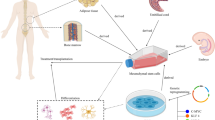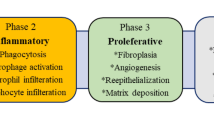Abstract
The focus of this study was to compare the role of nerve growth factor (NGF) and vascular endothelial growth factor (VEGF) in the regeneration of experimental skin and cartilage trauma. The role of VEGF in this process is known since decade; the NGF participation on this process has been first discussed within the spinal cord injury repair. We hypothesized that both VEGF and NGF induce angiogenesis and take part on the repair process. The angiogenesis response and the cartilage regeneration after phVEGF165 plasmid and rat pcNGF plasmid administration were investigated using BALB/c mice. PhVEGF165 and pcNFG were injected into the right mice ear and plain vector injection into the left ear the day before trauma. The next day, all mice were ear-punched, resulting in 2-mm diameter puncture through the center of both pinnae. In BALB/c mouse strain, a significantly faster cartilage repair was observed after phVEGF165 and pcNGF injection into punched ear area in comparison to the control group. It has been shown that the healing process is after VEGF and NGF injection driven differentially. In case of VEGF is the cartilage wound repaired by induction of new chondrocytes differentiation. In the case of NGF, the regeneration is supported by immature leukocytes attracted into the punched area. The leukocytes induct angiogenesis so far indirectly by inflammation. The NGF-induced inflammation environment may be a part of mosaic creating the complete picture of regeneration.





Similar content being viewed by others
References
Ansel JC, Brown JR, Payan DG, Brown MA (1993) Substance P selectively activates TNF-alpha gene expression in murine mast cells. J Immunol 150:4478
Cantarella G, Lempereur L, Presta M, Ribatti D, Lombardo G, Lazarovici P, Zappala G, Pafumi C, Bernardini R (2002) Nerve growth factor-endothelial cell interaction leads to angiogenesis in vitro and in vivo. FASEB J 16:1307
Carlevaro MF, Cermelli S, Cancedda R, Descalzi Cancedda F (2000) Vascular endothelial growth factor (VEGF) in cartilage neovascularization and chondrocyte differentiation: auto-paracrine role during endochondral bone formation. J Cell Sci 113(Pt 1):59
Cordeiro PG, Seckel BR, Lipton SA, D’Amore PA, Wagner J, Madison R (1989) Acidic fibroblast growth factor enhances peripheral nerve regeneration in vivo. Plast Reconstr Surg 83:1013
Dvorak HF, Nagy JA, Feng D, Brown LF, Dvorak AM (1999) Vascular permeability factor/vascular endothelial growth factor and the significance of microvascular hyperpermeability in angiogenesis. Curr Top Microbiol Immunol 237:97
Emanueli C, Salis MB, Pinna A, Graiani G, Manni L, Madeddu P (2002) Nerve growth factor promotes angiogenesis in ishcemic hindlimbs. Circulation 106:2257
Eppley BL, Doucet M, Connolly DT, Feder J (1988) Enhancement of angiogenesis by bFGF in mandibular bone graft healing in the rabbit. J Oral Maxillofac Surg 46:391
Fukino K, Sata M, Seko Y, Hirata Y, Nagai R (2003) Genetic background influences therapeutic effectiveness of VEGF. Biochem Biophys Res Commun 310:143
Gerber HP, Vu TH, Ryan AM, Kowalski J, Werb Z, Ferrara N (1999) VEGF couples hypertrophic cartilage remodeling, ossification and angiogenesis during endochondral bone formation. Nat Med 5:623
Graiani G, Emanueli C, Desortes E, Van Linhout S, Pinna A, Figureoa CD, Manni L, MAdeddu P (2004) Nerve growth factor promoted reparative angiogenesis and inhibits endothelial apoptosis in cutaneous wounds of Type 1 diabetic mice. Diabetologia 47:1047
Iannone F, De Bari C, Dell’Accio F, Covelli M, Patella V, LoBianco G, Lapadula G (2002) Increased expression of nerve growth factor (NGF) and high affinity NGF receptor (p140TrkA) in human osteoarthritic chondrocytes. Rheumatology 41:1413
Isner JM, Pieczek A, Schainfeld R, Blair R, Haley L, Asahara T, Rosenfield K, Razvi S, Walsh K, Symes JF (1996) Clinical evidence of angiogenesis after arterial gene transfer of phVEGF165 in patient with ischaemic limb. Lancet 348:370
Isner JM, Rosenfield K (1993) Redefining the treatment of peripheral artery disease. Role of percutaneous revascularization. Circulation 88:1534
Khouri RK, Hong SP, Deune EG, Tarpley JE, Song SZ, Serdar CM, Pierce GF (1994) De novo generation of permanent neovascularized soft tissue appendages by platelet-derived growth factor. J Clin Invest 94:1757
Levi-Montalcini R (1987) The nerve growth factor 35 years later. Science 237:1154
Manni L, Antonelli A, Costa N, Aloe L (2005) Stress alters vascular-endothelial growth factor expression in rat arteries: role of nerve growth factor. Basic Res Cardiol 2005:121
Matsuda H, Koyama H, Sato H (1998) Role of nerve growth factor in cutaneous wound healing: accelerating effects in normal and healing-impaired diabetic mice. J Exp Med 187:297
Nomoto H, Takaiwa M, Mouri A, Furukawa S (2007) Pro-region of neurotrophins determines the processing efficiency. Biochem Biophys Res Commun 18;356(4):919–924
Olech VM, Keshavjee SH, Chamberlain DW, Slutsky AS, Patterson GA (1991) Role of basic fibroblast growth factor in revascularization of rabbit tracheal autografts. Ann Thorac Surg 52:258
Payan DG, McGillis JP, Renold FK, Mitsuhashi M, Goetzl EJ (1987) Neuropeptide modulation of leukocyte function. Ann N Y Acad Sci 496:182
Petersen W, Pufe T, Starke C, Fuchs T, Kopf S, Raschke M, Becker R, Tillmann B (2005) Locally applied angiogenic factors—a new therapeutic tool for meniscal repair. Ann Anat 187:509
Raychaudhuri SK, Raychaudhuri PS, Weltman H, Farber EM (2001) Effect of nerve growth factor on endothelial cell biology: proliferation and adherence molecule expression on human dermal microvascular endothelial cells. Arch Dermatol Res 293:291
Spyridopoulos I, Brogi E, Kearney M, Sullivan AB, Cetrulo C, Isner JM, Losordo DW (1997) Vascular endothelial growth factor inhibits endothelial cell apoptosis induced by tumor necrosis factor-alpha: balance between growth and death signals. J Mol Cell Cardiol 29:1321
Street J, Bao M, deGuzman L, Bunting S, Peale FV Jr, Ferrara N, Steinmetz H, Hoeffel J, Cleland JL, Daugherty A, van Bruggen N, Redmond HP, Carano RA, Filvaroff EH (2002) Vascular endothelial growth factor stimulates bone repair by promoting angiogenesis and bone turnover. Proc Natl Acad Sci USA 99:9656
Takeshita S, Isshiki T, Ochiai M, Eto K, Mori H, Tanaka E, Umetani K, Sato T (1998) Endothelium-dependent relaxation of collateral microvessels after intramuscular gene transfer of vascular endothelial growth factor in a rat model of hindlimb ischemia. Circulation 98:1261
Taylor PC (2002) VEGF and imaging of vessels in rheumatoid arthritis. Arthritis Res 4(Suppl 3):S99
Tsurumi Y, Takeshita S, Chen D, Kearney M, Rossow ST, Passeri J, Horowitz JR, Symes JF, Isner JM (1996) Direct intramuscular gene transfer of naked DNA encoding vascular endothelial growth factor augments collateral development and tissue perfusion. Circulation 94:3281
Yanagisawa-Miwa A, Uchida Y, Nakamura F, Tomaru T, Kido H, Kamijo T, Sugimoto T, Kaji K, Utsuyama M, Kurashima C et al (1992) Salvage of infarcted myocardium by angiogenic action of basic fibroblast growth factor. Science 257:1401
Yancopoulos GD, Davis S, Gale NW, Rudge JS, Wiegand SJ, Holash J (2000) Vascular-specific growth factors and blood vessel formation. Nature 407:242
Acknowledgments
The study was supported by the research project MSM No. 002 162 0816 and by research project MŠMT ME831 at the Third Faculty of Medicine Charles University Prague and by the research project of the MSM No. 002 162 0807.
Author information
Authors and Affiliations
Corresponding author
Rights and permissions
About this article
Cite this article
Kolostova, K., Taltynov, O., Pinterova, D. et al. Tissue repair driven by two different mechanisms of growth factor plasmids VEGF and NGF in mice auricular cartilage: regeneration mediated by administering growth factor plasmids. Eur Arch Otorhinolaryngol 269, 1763–1770 (2012). https://doi.org/10.1007/s00405-011-1821-6
Received:
Accepted:
Published:
Issue Date:
DOI: https://doi.org/10.1007/s00405-011-1821-6




